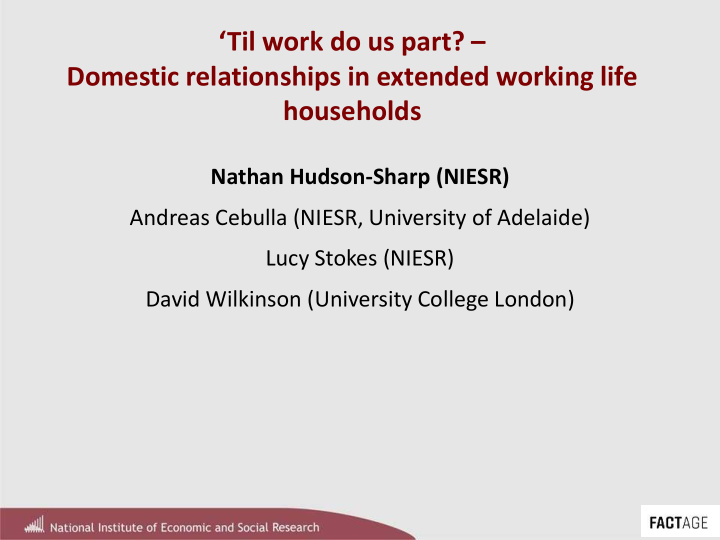



‘Til work do us part? – Domestic relationships in extended working life households Nathan Hudson-Sharp (NIESR) Andreas Cebulla (NIESR, University of Adelaide) Lucy Stokes (NIESR) David Wilkinson (University College London)
‘Til work do us part? – Domestic relationships in extended working life households 1. Background Literature • National and comparative studies on domestic divisions of labour (DDL) 2. Our research on DDL in extending working life households in the UK. • Panel Data: Understanding Society. • Persistence of gender inequality in the DDL in EWL. 3. Policy implications
Extending Working Lives: A Household Issue Policy debate largely frames the issue of retirement in terms of individual decision-making (Loretto and Vickerstaff, 2013) In 2017, of the population aged 16 years and over, 61.4% were living as a couple in England and Wales (ONS, 2017) % of people aged 55-64 by living arrangement Living in a couple: Married or civil partnered 65% Living in a couple: Cohabiting - never married or civil 4% partnered Living in a couple: Cohabiting- previously married or 5% civil partnered Not living in a couple: Never married or civil 9% partnered Not living in a couple: Previously married or civil 17% partnered 0% 10% 20% 30% 40% 50% 60% 70% Source: (ONS, 2017)
Housework: A Policy Issue? Austria: Spitzer and Hammer (2016) Italy: Campolo et al. (2016) Germany: Leopold and Skopek (2015; 2016; 2018) Sweden: Ruppanner et al. (2017; 2018) Switzerland: Henchoz and Wernli (2014) USA: Bianchi et al. (2000); Geist and Tabler (2018) UK: Brown and Roberts (2014); Lyonette and Crompton (2015) Cross-National: Kan et al. (2008; 2011); Tai and Baxter (2018 ) “One of the most pressing issues contributing to the persistence of gender inequality is the gendered division of domestic labour” (Lyonette and Crompton, 2015:23) “Gender segregation in domestic work continues to pose a barrier to gender equality” (Kan et al., 2011:235)
Time Spent on Domestic Work (minutes per day) Women (aged 20-59) 450 Canda 400 UK USA 350 Australia 300 France Netherlands 250 Germany 200 Slovenia Denmark 150 Norway 100 Finland Sweden 50 Italy 0 Spain 1961-69 1970-75 1976-84 1985-89 1990-94 1995-99 2000-04 Israel Men (aged 20-59) 450 Canda UK 400 USA 350 Australia France 300 Netherlands 250 Germany Slovenia 200 Denmark Norway 150 Finland 100 Sweden Italy 50 Spain 0 Israel 1961-69 1970-75 1976-84 1985-89 1990-94 1995-99 2000-04 Source: Kan et al. (2011) – Multinational Time Use Study
What we know about domestic divisions of labour “Women spend more than 3 times longer doing housework in a week than men” (Brown and Roberts, 2014) 49%* 85%* *Source: Eurofound 2017
DDL and Retirement Studies using German and Italian panel data have separately shown that men respond to retirement transitions by increasing their hours spent on domestic tasks and taking over some of the work previously performed by their wives. (Leopold & Skopek, 2015; Caltabiano, Campolo, & di Pino, 2015) Analyses of coupled German panel data however show men never perform more than 40% of the households domestic hours, even when their wife is in employment (Leopold & Skopek, 2016) Men’s increase is not permanent, with couples reverting back to pre - retirement divisions of labour (Leopold & Skopek, 2016)
DDL and Extending Working Life For older workers in partnered households, the gendered division of domestic labour prevails (Cebulla et al., 2007). Our analysis: Understanding Society Waves 2 and 4. (Extended Working Life) Pre-ERA Post-ERA Men: 59 to 64 65 to 70 ERA Women : 58 to 63 64 to 69 Sample: Men aged 59 to 70, and women aged 58 to 69, who are in a cohabitating or in legal marriage or civil partnership.
Preliminary Findings Women spend, on average, 12.9 hours a week on housework* Men spend, on average, 5.9 hours a week on housework*. *Aged 16-60 Men Women 14.1 13.6 13.5 13.4 11.9 13.2 10.5 8.7 10.5 6.3 6.0 5.8 5.8 5.9 5.7 5.7 5.4 2.3 16-19 20-24 25-29 30-34 35-39 40-44 45-49 50-54 55-59 Source: Understanding Society, Wave 2
Preliminary Findings Self-reported hours spent on housework per week 20.0 18.0 17.3 18.0 15.8 16.0 13.5 14.0 12.0 10.0 Men 7.6 8.0 6.7 Women 6.0 4.7 4.3 4.0 2.0 0.0 Pre-ERA, Post-ERA, Pre-ERA, Post-ERA, working working retired retired EWL Source: Understanding Society, Wave 2
Preliminary Findings Who does the DIY? 100% 80% 60% 40% 20% 0% Men Woman Mostly self Mostly spouse/partner Shared Who does the washing / ironing 100% 80% 60% 40% 20% 0% Men Women Mostly self Mostly spouse/partner Shared Source: Understanding Society, Wave 2
Preliminary Findings EWL respondents hour spent on housework, by partner status 18.0 17.0 15.8 15.2 16.0 14.4 14.0 12.0 10.0 7.2 8.0 6.0 3.9 3.7 4.0 3.1 2.0 0.0 Pre-ERA, working Post-ERA, working Pre-ERA, retired Post-ERA, retired Women Men Source: Understanding Society, Wave 2
Preliminary Findings Wave 4 Wave 2 Pre-ERA Post-ERA Men: 59 to 64 65 to 70 Women : 58 to 63 64 to 69 Women who extend their working lives decrease hours spent from 13.9 to 13.6 hours Men who extend their working lives increase hours spent on housework from 5.2 to 6.2 hours Source: Understanding Society, Waves 2 & 4
Limitations Survey data are a rather blunt instrument for fully understanding the complexities between the domestic divisions of labour and the nuances of negotiations between couple Issues around the accuracy of reporting , particularly for men. Income, employment and education define the power relations between couples, and subsequent negotiations around domestic divisions of labour Health and Ageing: Geist and Tabler (2018) Ethnicity: Kan and Lamie (2018) Socioeconomic Class: Usdansky (2011) Same-Sex Couples: Bernando et al. (2011); Kelly et al. (2015)
Thinking about Policy Cultural and structural discrimination of women. Work-life tensions for older women. Modified male breadwinner model: domestic work pulling women away from the labour market Are unequal domestic divisions of labour counter-productive to the goal of extending women’s working lives?
Recommend
More recommend